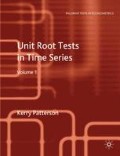Abstract
The first part of this chapter introduces the random walk initially in a form with stochastic shocks generated by a random variable with a binomial distribution. In the simplest version of this process the random variable has two equally likely outcomes resulting in a symmetric binomial random walk. The idea is simple enough and the terminology is due to a problem posed by Pearson (see Hughes, 1995, p.53), although the concept dates from much earlier, originating in games of chance. Starting from the origin, at regular intervals a walker takes equally spaced steps either to the left (north) or to the right (south), with equal probability. The walker’s progress can be plotted in two dimensions by recording the distance from the origin on the vertical axis and the elapsed time on the horizontal axis; for example, one step to the north followed by one step to the south returns the walker to the origin. Such a graph will look like a series of equally sized steps, see Figure 1.1; perhaps surprisingly, the resulting path does not generally oscillate around zero, the theoretical mean of the process. This lack of ‘mean reversion’ is one of the key characteristics of a random walk. In this form the process has its origins in gambling, where the gambler gains or loses an equal amount at each gamble, with equal probability, and intuition might suggest that the gambler is not systematically losing or winning. The ‘distance from the origin’ corresponds to the gambler’s win/lose tally, which is one-dimensional and can be represented on the vertical axis.
Access this chapter
Tax calculation will be finalised at checkout
Purchases are for personal use only
Preview
Unable to display preview. Download preview PDF.
Copyright information
© 2011 Kerry Patterson
About this chapter
Cite this chapter
Patterson, K. (2011). Introduction to Random Walks and Brownian Motion. In: Unit Root Tests in Time Series. Palgrave Texts in Econometrics. Palgrave Macmillan, London. https://doi.org/10.1057/9780230299306_1
Download citation
DOI: https://doi.org/10.1057/9780230299306_1
Publisher Name: Palgrave Macmillan, London
Print ISBN: 978-0-230-25025-3
Online ISBN: 978-0-230-29930-6
eBook Packages: Palgrave Economics & Finance CollectionEconomics and Finance (R0)

